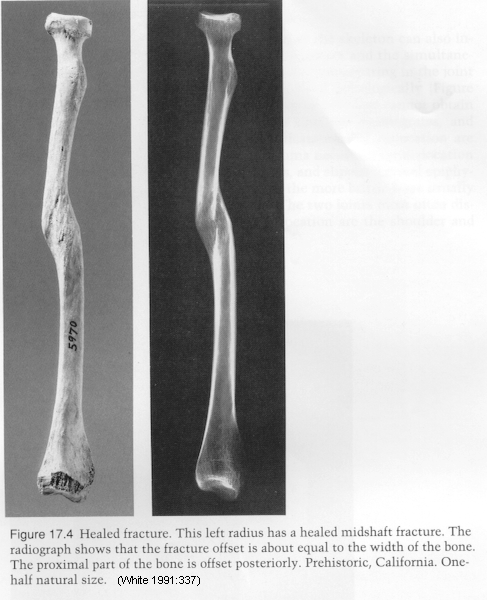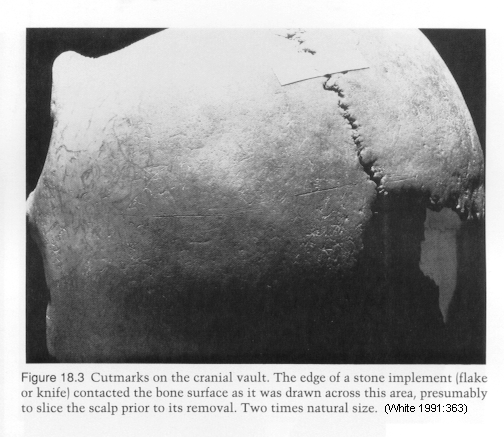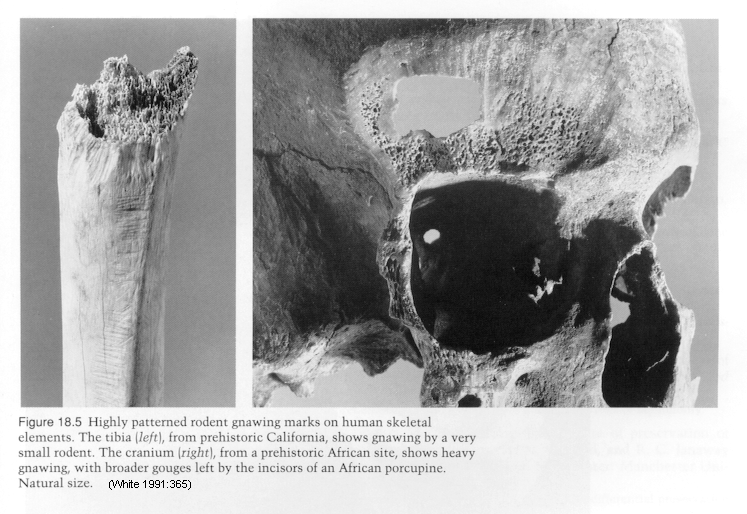

INTRODUCTION
The analytical stage of forensic anthropology involves answering questions that lead to identification of the individual whose remains are being examined. The questions asked in developing a biological or demographic profile for an individual include the following:
OBJECTIVES
READINGS
TERMS
GENERAL INSTRUCTIONS
SKELETAL TRAUMAS
TYPES OF SKELETAL TRAUMAS
A variety of skeletal traumas, or damage to bones as a result of the application of force via accident or an instrument or weapon, may be manifested in forensic cases and may be used in developing a biological profile. Skeletal traumas include bone fractures, blunt-force traumas, sharp-force traumas, gunshot traumas, burning, amputation, and dislocation. Each of these skeletal traumas was discussed and illustrated in class. In this lab we'll examine and assess bone fractures and sharp-force traumas.
Bone fractures include a variety of breaks to bones that result from the application of unusual forces to bone. Depending on the type and magnitude of force and the skeletal effects, bone fractures are divided into at least eight types (Sciulli 1991).
The image below shows a healed bone fracture that was likely a complete fracture.

Sharp-force traumas are incised wounds and stab wounds resulting from attacks or accidents with knives, swords, axes, and other sharp implements. Such injuries cause bone cracks, incisions, scratches, gouges, piercing, and fragmentation of bone. The size and shape of sharp-force traumas provide clues to the instrument that caused the damage, the direction of the attack or accident, and the nature of the events leading to an individual's death (Rhine 1998, Sciulli 1991).
Sharp-force traumas resulting from attacks with metal objects and stone objects must be distinguished from skeletal modifications from postmortem taphonomic processes like rodent gnawing, carnivore gnawing, and trampling. Metal and stone objects leave single, V-shaped incisions that have straight parallel edges. Such traumas could be antemortem, perimortem, or postmortem. Rodent gnawing leaves paired, U-shaped parallel incisions on bones (Sciulli 1991), while carnivore gnawing leaves single, U-shaped incisions or "channels" on bones. While cut marks and incisions tend to be found on the highest relief parts of bones, rodent and carnivore gnawing marks may be found in bone depressions as well. We will examine rodent gnawing and carnivore gnawing in Lab 12.
The images below illustrate incisions resulting from sharp-force trauma with a stone instrument and rodent gnawing that resembles sharp-force incision traumas.


It is important to assess when skeletal traumas occurred - before death, at the time of death, or after death. Skeletal traumas occurring before death may be useful in identifying an individual's identity if those traumas were documented in writing or, better yet, x-rays by physicians or if they required medical hardware to repair. Skeletal traumas incurred at the time of death may be potential causes of death or may be used to reconstruct the events of the crime. Skeletal traumas incurred after death are usually the result of taphonomic processes or improper retrieval and transport of skeletal remains (Rhine 1998, Pickering and Bachman 1997).
Skeletal traumas that were incurred before death are called antemortem traumas. They are distinguished by nondifferential weathering and more-or-less even discoloration of the trauma site as well as evidence of healing in the form of calluses or bone remodeling (Rhine 1998).
Perimortem traumas are those incurred at the time of death. The effected bones will show no evidence of healing and will be nondifferentially weathered and discolored. Radiating fractures are often present (Rhine 1998). Fractures often spiral around the diaphysis.
Skeletal traumas incurred after death are called postmortem
traumas.
The effected bones will show no evidence of healing and will be
differentially
weathered and discolored. The trauma edges will be fresher and sharper
than those resulting from perimortem traumas. Longitudinal
fractures
may be present (Rhine 1998). Fractures are often perpendicular to
the diaphysis.
ASSIGNMENT
Record all answers neatly in pencil on the answer sheet. Metric
answers should be reported to the level of accuracy (tenths place, ones
place, etc.) specified for those questions on the answer sheet. Metric
answers, if appropriate, must have units.
Examine the skeletal specimens and casts, carefully handling
the bones. For each specimen you will answer questions related to (1)
the skeletal element (e.g., bone name, side, end); (2) the nature of
the trauma (e.g., length, diameter, color); (3) the specific type of
trauma; and (4) the timing of the trauma (e.g., antemortem, perimortem,
postmortem).
Bass, W. M.
1987 Human Osteology: A Laboratory and Field Manual
(3rd ed.). Missouri Archaeological Society, Columbia.
Byers, Stephen N.
2005 Introduction to Forensic
Anthropology: A Textbook. Allyn and Bacon, Boston.
Byers, Stephen N. and Susan M.T. Myster
2005 Forensic Anthropology
Laboratory Manual. Allyn and Bacon, Boston.
France, D. L.
2003 Lab Manual and Workbook for Physical
Anthropology
(5t ed.). West/Wadsworth, Belmont, CA.
Pickering, R.B. and D.C. Bachman
1997 The Use of Forensic
Anthropology.
CRC Press, Boca Raton.
Rhine, S. R.
1998 Bone Voyage: A Journey in Forensic
Anthropology.
University of New Mexico Press, Albuquerque.
Sciulli, P.
1991 Class notes, Biocultural Adaptations in
Prehistory.
The Ohio State University, Columbus.
Spitz, W. U. (editor)
1993 Spitz and Fisher's
Medicolegal
Investigation of Death (3rd ed.). Charles C. Thomas,
Springfield,
Illinois.
White, T. D.
1991 Human Osteology. Academic Press, San
Diego.